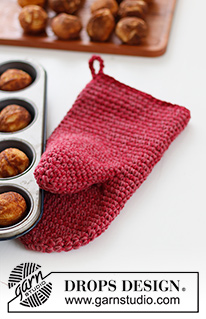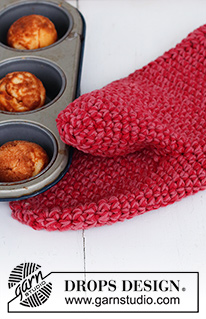Comments / Questions (7)
![]() Mireille Lehoulle wrote:
Mireille Lehoulle wrote:
Bonjour est-ce qu'il serait possible d'avoir les explications de ce modèle tricoté aux aiguilles ? merci
10.05.2025 - 10:01DROPS Design answered:
Bonjour Mme Lehoulle, il n'existe qu'une version crochet de ce modèle, si vous préférez une version tricot, vous pouvez par exemple ne tricoter qu'une seule moufle en suivant un modèle - par exemple de moufles feutrées, ici. Bon tricot!
12.05.2025 - 07:43
![]() Anna wrote:
Anna wrote:
Thank you very much for the instructions on knitting a mitten-potholder. I will tell you what problems I had - maybe it will help someone (maybe I don't know the language well and didn't understand it right away). The number of loops is given for three sizes, you need to choose a size, and, accordingly, the number of loops, and I thought you need to put markers. But then everything became clear, thank you for the good instructions! I knitted from textile yarn
23.10.2024 - 14:36
![]() April wrote:
April wrote:
Hi this appears to be for a right hand? How can I make a left hand one?
23.06.2024 - 09:46DROPS Design answered:
Dear April, this pattern is rather smmetric, yo you can use it with both hand. The only thing, is the little loop that can be put on the other side. Happy Stitching!
23.06.2024 - 15:17
![]() Helen Henricsson wrote:
Helen Henricsson wrote:
Finns det någon video på hur man virkar grillvanten?
20.03.2024 - 10:51DROPS Design answered:
Hej Helen. Nej dessvärre finns det ingen video till hela mönstret, men det finns videor för de olika maskorna. Mvh DROPS Design
20.03.2024 - 14:30
![]() Marina wrote:
Marina wrote:
Som vanlig kommer Drops med en ubrukelig oppskrift hvor forklaring er så på jordet dumt forklart, at etter 1 runde var arbeidet vridd og lite gøy å fortsette på. Tror ikke jeg har funnet èn oppskrift hvor forklaring er så lett å forstå at selv et barn klarer det. Har ikke problemer med oppskrifter fra andre, så det er ikke JEG som er problemet. Ubrukelig nettside.
19.03.2023 - 07:47
![]() Valérie wrote:
Valérie wrote:
Hello. Is there any chance to have the pattern to be made for felting for effective heat protection ? Love your patterns
13.02.2022 - 23:05
![]() Annika Lindow wrote:
Annika Lindow wrote:
Hej! Går det åt 200 gram garn till en grillvante?
11.01.2022 - 16:38DROPS Design answered:
Hej Annika. Ja det stämmer. Mvh DROPS Design
12.01.2022 - 14:25
Holiday Mitts#dropsholidaymitts |
|
 |
 |
Crocheted barbeque mitten in 2 strands DROPS Paris. Theme: Christmas.
DROPS Extra 0-1550 |
|
|
---------------------------------------------------------- EXPLANATION FOR THE PATTERN: ---------------------------------------------------------- CROCHET TIP FOR CHAIN STITCH: If you work at the end of crochet hook the chain stitch will often be too tight. 1 chain stitch should be just as long as 1 double crochet is wide. CROCHET INFORMATION: At beginning of every round work 1 chain stitch – this chain stitch does not replace first double crochet but is in addition. Finish round with 1 slip stitch in chain stitch at beginning of round. DECREASE TIP: Work 2 double crochets together into 1 double crochet as follows: Insert hook through first stitch and get the yarn, insert hook through next stitch and get the yarn (= 3 loops on hook), make 1 yarn over and pull yarn over through all 3 loops on hook (= 1 double crochet decreased). ---------------------------------------------------------- START THE PIECE HERE: ---------------------------------------------------------- BARBEQUE MITTEN – SHORT OVERVIEW OF THE PIECE: The piece is worked from the hand towards the fingers. Work entire barbeque mitten with 2 strands. BARBEQUE MITTEN: Begin with crochet hook 5.5 mm and 2 strands in bordeaux DROPS Paris. Work 46-48-52 chain stitches - read CROCHET TIP FOR CHAIN STITCH. Turn piece, skip the first 12 chain stitches (= strap for hanging), then work 1 double crochet in every chain stitch the entire row = 34-37-40 double crochets. Form a ring by working 1 slip stitch in first double crochet on row. Switch to 1 strand colour bordeaux and 1 strand colour plum in DROPS Paris (= 2 strands). Then work piece in the round with 1 double crochet in every double crochet - read CROCHET INFORMATION and REMEMBER THE CROCHET TENSION! When piece measures 16-17-18 cm, worked an opening for thumb as follows: Work 1 double crochet in first double crochet, work 11-13-14 chain stitches, skip the next 15-16-18 double crochets, work 1 double crochet in each of the remaining 18-20-21 double crochets = 30-34-36 stitches (11-13-14 chain stitches and 19-21-22 double crochets). Continue with 1 double crochet in every stitch until piece measures 24-26-27 cm (5-6-7 rounds remain until finished measurements). Insert a marker thread at the beginning of the round and another marker thread after 15-17-18 double crochets. Now decrease on each side of both marker threads as follows: Work 2 double crochet together before and after both markers threads - read DECREASE TIP (= 4 double crochets decreased). Decrease like this every round 5-6-7 times in total = 10-10-8 double crochets remain. Turn the piece inside out and place it flat. Then work the 10-10-8 double crochets together between both layers = 5-5-4 double crochets. Fasten off. Turn the piece with right side outwards. Barbeque mitten measures approx. 28-30-32 cm from top and down. THUMB: Use crochet hook size 5.5 mm and 1 strand colour bordeaux and 1 strand colour plum (= 2 strands). Work 1 double crochet in each of the 15-16-18 double crochets along opening for thumb, and work 11-12-14 double crochets in the chain stitch row worked = 26-28-32 double crochets. Insert a marker thread at the beginning of the round and 1 marker thread after 13-14-16 double crochets. Then work thumb in the round with 1 double crochet in every double crochet. When 2-3-3 rounds have been worked with double crochets, decrease as follows on next round: Work 2 double crochet together before and after both markers threads - remember DECREASE TIP (= 4 stitches decreased). Decrease like this every other round 4-4-5 times in total = 10-12-12 double crochets remain. On next round work 1 double crochet in each of the first 2-0-0 next double crochets then work the next double crochets together 2 by 2 = 6-6-6 double crochets remain. Turn thumb inside out, place it flat and work the 6-6-6 double crochets together between both layers = 3-3-3 double crochets. Fasten off. Turn the thumb with right side outwards. Thumb measures approx. 8-9-10 cm. |
|
Have you finished this pattern?Tag your pictures with #dropspattern #dropsholidaymitts or submit them to the #dropsfan gallery. Do you need help with this pattern?You'll find 7 tutorial videos, a Comments/Questions area and more by visiting the pattern on garnstudio.com. © 1982-2025 DROPS Design A/S. We reserve all rights. This document, including all its sub-sections, has copyrights. Read more about what you can do with our patterns at the bottom of each pattern on our site. |
|











































Post a comment to pattern DROPS Extra 0-1550
We would love to hear what you have to say about this pattern!
If you want to leave a question, please make sure you select the correct category in the form below, to speed up the answering process. Required fields are marked *.